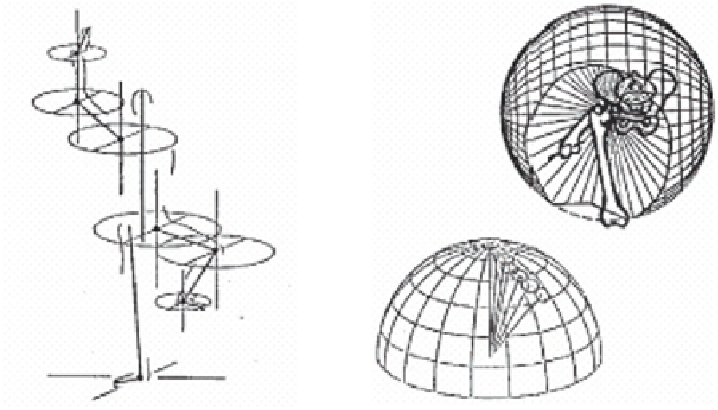Database Reference
In-Depth Information
Figure 2: Virtual globes and globographic motion
Conceptually, we assume a virtual globe at each link connecting a joint. We treat a joint,
located at the base of every limb, as a permanent motion center. Thus, movement made by
a limb takes place on the surface of a sphere, i.e.,
every movement outlines an imaginary
shoreline on the sphere's surface
. This is shown in Figure 2.
A totally different representation approach is based on indicating the location of every
joint in the external space, rather than on relative changes of geometric relations, that is, on
the
absolute position
of the body's links. This so-called
key frames
approach to motion
representation is very common in computer graphics, as well as in robotics.
Using the defi nition of motion above, it is possible to represent and store the basic data
required for executing motion performed by any vertebrate body using
seven bits per joint
per time unit
. This is defi ned as the
motion byte
. Table 2 depicts this basic 7-bit structure
of the motion byte, showing all possible combinations of motion states.
Generally, the motion byte does not need to use all of the 7-bit binary combinations.
The “not relevant” cells in Table 2 represent the unused combinations. Moreover, on certain
occasions there is no need to use all seven bits of the motion byte, as follows:
To represent motion between two limbs with a joint that has only
one
degree of free-
dom, the motion byte consists of only three bits: one bit for the coordination aspect,
and two more bits to represent the space aspect (Space 1
st
D).
•
st
D).
st
To represent motion between two limbs with a joint that has only
two
degrees of
freedom, the motion byte needs only fi ve bits: one bit for the coordination aspect, and
four more bits to represent the space aspect (Space 1
st
D and Space 2
•
nd
D).
nd
D).
nd
st
D and Space 2
Thus, the number of bits in the motion byte according to the motion degrees of free-
dom used by the represented body may be reduced. A creature such as an anthropomorphic



